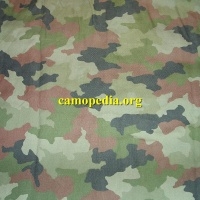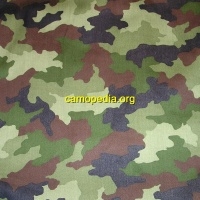Camouflage pattern M87 (JUG)
The state of Yugoslavia was founded in 1918 immediately after the conclusion of all the well-known events of the First World War. The Kingdom of Serbs, Croats, and Slovenes later became the Kingdom of Yugoslavia in 1929 under the rule of King Alexander I. During World War II, this state was occupied by Axis forces. At that time, only Croatia could secede from the rest of the state as the only independent state. The anti-German/anti-occupation movement logically just grew in such an environment, leading to the creation of the National Liberation Army (another name for local partisans).
Although it started locally and small, over time it developed into the largest resistance movement on a European scale. It was this movement that dealt with the Nazis locally in 1944-1945, which eventually led to the establishment of the brand-new Federal People's Republic of Yugoslavia in 1946. It was a confederation of a total of six republics: Bosnia, Herzegovina, Croatia, Macedonia, Montenegro, Slovenia, and Serbia, plus two autonomous provinces Kosovo and Vojvodina. Later, the state was renamed the Socialist Federal Republic of Yugoslavia in 1963, when the well-known former local war hero Marshal Josip Broz Tito became its president.
He made quite a career here, considering he became an honorary lifelong president of the area (previously he was only a prime minister). Although all the local republics and provinces had their own constitution, supreme court, parliament, prime minister, etc., any excessive desires for greater national identity and autonomy were quickly suppressed by Tito (the most famous event is undoubtedly from 1970-1971, known as the "Croatian Spring," which was a liberalization process in the Socialist Republic of Croatia).
When President Tito died in 1980, some ethnic disagreements and conflicts began to appear. However, it wasn't until 1990 that the local republic truly began to fall apart. In June 1991, Croatia and Slovenia declared their independence from Yugoslavia, and in September of the same year, Macedonia also declared its independence. In 1992, Bosnia and Herzegovina were recognized by most European states. Each of these states then had only its own sovereign history and path through history.
Montenegro and Serbia remained together as the Federal Republic of Yugoslavia until 2003. At that time, the entity was renamed "State Union of Serbia and Montenegro." This union, however, lasted only three years, and precisely in 2006, Montenegro officially separated as the "Republic of Montenegro."
The Yugoslav Army was initially designated JNA ("Jugoslovenska Narodna Armija") from 1945 to 1992. After that, it was called "Vojska Jugoslavije (VJ)", and it remained such until 2003, when it became "Vojska Srbije i Crna Gore" ("Army of Serbia and Montenegro").
What camouflage patterns were used, among others, in Yugoslavia?
The M87 camouflage pattern with small leaves was tested by reconnaissance units of the 63rd Air Brigade and some other local military police. This took place between 1986 and 1988. It is the same pattern as worn in Slovenia, only with different color shades. However, it was never officially adopted into equipment.


As for the other variation of the M89 camouflage pattern, it began to be used from 1990 in the JNA. It was the army's standard camouflage pattern at that time until 2003. The pattern was used by the Bosnian Serb Army and Serbian forces in Croatia.






























































































































